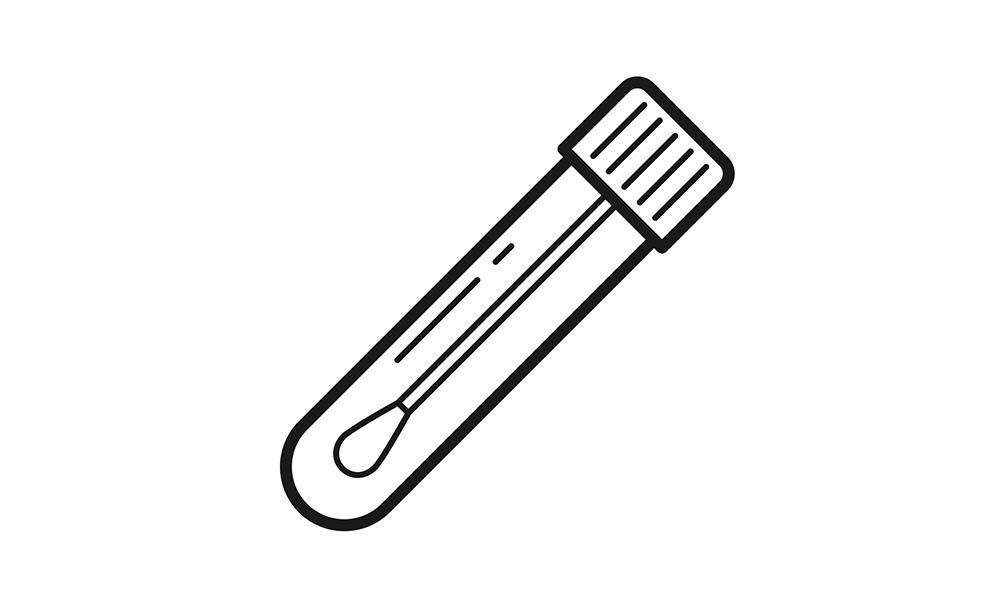An aptasensor has been designed to detect the SARS-CoV-2 virus in saliva
12/20/21
Scientists at the Universidad Carlos III de Madrid (UC3M) have developed the first photo-electrochemical aptasensor that detects the SARS-CoV-2 virus in a saliva sample. This sensor, which uses aptamers (a type of artificial antibody), is more sensitive that antigen-based sensors and detects the virus more quickly and cheaply than PCR tests. These new devices can be incorporated into portable diagnostic systems and are easy to use.

The new aptasensor has a wide range of sensitivity to different virus concentrations. It is thus capable of detecting concentrations below 0.5 nanomolars (nM), typical in patients who have not yet developed COVID symptoms, as well as working at higher concentrations (up to 32 nM), so it could provide clinical practices with an extra tool for monitoring the progress of infection in patients.
It would be used in a similar way to current antigen sensors: a sample of the patient’s saliva is dissolved in a buffer solution and then placed on to the sensor’s surface. The measurement would be available in a few minutes. “The advantage over current antigen-based sensors is the greater sensitivity and specificity of the photo-electrochemical sensor measurements, which are comparable to more complex measurements, such as those from fluorescence-based sensors, and they are simpler, cheaper, and faster than PCR-based sensors,” says the research’s lead author, Mahmoud Amouzadeh Tabrizi, CONEX-Plus researcher at the UC3M’s Department of Electronic Technology.
The science behind the aptasensor
A photo-electrochemical sensor can be likened to a solar cell or the process of photosynthesis: in both cases, given the presence of light (photons), a specific material (or molecule) is able to generate an electrical current (electrons). “In our case, we used a surface that contains graphitic carbon nitride-cadmium sulphide quantum dots (C3N4-CdS) with photoactive properties. It is on this surface that a specific receptor is immobilised in such a way that, in the presence of the target molecule, it binds to the bioreceptor, thereby reducing the current generation associated with the presence of light. On this particular sensor, the bioreceptor used is an aptamer that is capable of interacting with the receptor-binding domain (RBD) of the SARS-CoV-2 virus, hence the name photo-electrochemical aptasensor,” explains Mahmoud Amouzadeh Tabrizi. The results of this and other research by the group concerning the detection of SARS-CoV-2 in saliva were recently published in several scientific journals, such as Sensors and Actuators B: Chemical and Biosensors and Bioelectronics.
“The idea now is to supplement these results, using the research group’s experience, with the development of comprehensive biomedical instruments and diagnostics in order to create a high-sensitivity and specificity, portable and potentially low-cost diagnostic system that can eventually be used in clinical practice,” notes another of the authors, Pablo Acedo, head of the UC3M’s Sensors and Instrumentation Techniques Group (SITec). “We are seeking a diagnosis similar to those currently available when reading blood glucose levels in patients with diabetes, for example. We are also aiming to contact companies that may be interested in these developments,” he adds.
A critical factor when manufacturing this type of nanomaterial-based electrochemical sensor involves correctly characterising the surface of the material and the receiver that is immobilised on the surface. In order to do this, researchers have used various techniques and technologies, such as scanning electron microscopes (SEM), atomic force microscopy (AFM), and fourier-transform infrared spectroscopy (FTIR). “The results obtained from using all of these techniques allow us to ensure that both the manufacture of the desired photosensitive nanomaterial and the immobilisation of the bioreceptor has been properly carried out,” says Pablo Acedo.
This research is being undertaken within the framework of the BIOPIELTEC-CM (New Technologies for the Manufacture and Optimisation of Tissue: Skin as a Model System; P2018/BAA-4480) project. This consortium, which has received funding from the Regional Government of Madrid and the European Union, aims to bring together leading research groups from the Madrid region to face one of the most significant technological challenges within the biomedical and biotechnological field: developing technologies that manufacture tissue and organs, as well as organ-on-a-chip systems, and the optimisation of all of these technologies for their clinical and industrial application. In addition to this, the research has been made possible thanks to Mahmoud Amouzadeh Tabrizi joining the UC3M as a CONEX-Plus programme researcher, funded by the university and the European Commission through the Marie Skłodowska-Curie COFUND Actions (GA 801538) as part of the European Horizon 2020 Framework Programme.
More information:
Tabrizi, M.A. Nazari, L.Acedo, P. (2021). A photo-electrochemical aptasensor for the determination of severe acute respiratory syndrome coronavirus 2 receptor-binding domain by using graphitic carbon nitride-cadmium sulfide quantum dots nanocomposite. Sensors and Actuators B: Chemical, Volume 345, 130377, ISSN 0925-4005, https://doi.org/10.1016/j.snb.2021.130377 https://www.sciencedirect.com/science/article/pii/S092540052100945X
Tabrizi, M.A. Fernández-Blázquez, J. P. Medina, D.M, Acedo, P. (2022). An ultrasensitive molecularly imprinted polymer-based electrochemical sensor for the determination of SARS-CoV-2-RBD by using macroporous gold screen-printed electrode. Biosensors and Bioelectronics, Volume 196, 113729, ISSN 0956-5663, https://doi.org/10.1016/j.bios.2021.113729. https://www.sciencedirect.com/science/article/pii/S0956566321007661
--------------------